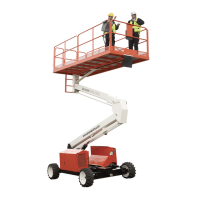SL30SL – 8210037
Appendix A – Glossary
aerial platform – a mobile device that has an adjustable position platform,
supported from ground level by a structure.
ambient temperature – the air temperature of the immediate environment.
authorized personnel – personnel approved as assigned to perform specic
duties at a specic location.
base – the relevant contact points of the aerial platform that form the stability
support (e.g. wheels, casters, outriggers, stabilizers).
center of gravity – the point in the aerial platform around which its weight
is evenly balanced.
chassis – the integral part of the aerial platform that provides mobility and
support for the scissors structure.
elevating assembly – the assembly located between the chassis and the
platform which is used to raise and lower the platform.
fall restraint – a system that is used while working on a boom lift within
the boundaries of platform guardrails to provide restraint from being pro-
jected upward from the platform. This system includes a harness or belt,
lanyard, and a lanyard anchor. Although federal regulations, OSHA, ANSI,
and Snorkel do not require the use of additional fall protection beyond the
platform guardrails on scissor lift aerial platforms, local, state, or employer
rules may require their use.
oor or ground pressure – the maximum pressure, expressed in pounds
per square inch, a single wheel concentrates on the oor or ground.
free-wheeling valve – a needle valve that, when adjusted open, allows
hydraulic uid to ow through the wheel drive motors. This allows the aerial
platform to be pushed or towed without damaged to the drive motors.
gradeability – the maximum slope that the aerial platform is capable of travel.
guardrail system – a vertical barrier around the platform to prevent per-
sonnel from falling.
hazardous location – any location that contains, or has the potential to con-
tain, an explosive or ammable atmosphere as dened by ANSI/NFPA 505.
level sensor – a device that detects a preset degree of variation from perfect
level. The level sensor is used to sound an alarm if operating on a slope
greater than the preset value.
lower controls – the controls located at ground level for operating some or
all of the functions of the aerial platform.
manufacturer – a person or entity who makes, builds or produces an
aerial platform.
maximum travel height – the maximum platform height or the most adverse
conguration(s) with respect to stability in which travel is permitted by the
manufacturer.
maximum wheel load – the load or weight that can be transmitted through
a single wheel to the oor or ground.
Minimum Safe Approach Distance (M.S.A.D.) – the minimum safe dis-
tance that electrical conductors may be approached when using the aerial
platform.
operation – the performance of any aerial platform functions within the scope
of its specications and in accordance with the manufacturer’s instructions,
the users work rules, and all applicable governmental regulations.
operator – a qualied person who controls the movement of an aerial platform.
personal fall arrest system – a fall protection system that is used while
working on an unprotected edge (such as a roof top with no guardrail). This
system includes a harness, lanyard or other connecting device, a fall arrestor,
an energy absorber or decelerator, an anchorage connector, and a secure
anchorage such as a building beam, girders or columns. An aerial platform
is not a fall arrest anchorage.
platform – the portion of an aerial platform intended to be occupied by
personnel with their tools and materials.
platform height – the vertical distance measured from the oor of the plat-
form to the surface upon which the chassis is being supported.
prestart inspection – a required safety inspection routine that is performed
daily before operating the aerial platform.
qualied person – a person, who by reason of knowledge, experience, or training
is familiar with the operation to be performed and the hazards involved.
rated work load – the designed carrying capacity of the aerial platform as
specied by the manufacturer.
stow – to place a component, such as the platform, in its rest position.
turning radius – the radius of the circle created by the wheel during a 360°
turn with the steering wheels turned to maximum. Inside turning radius is the
wheel closest to the center and outside turning radius is the wheel farthest
from the center.
unrestricted rated work load – the maximum designed carrying capacity of the
aerial platform allowed by the manufacturer in all operating congurations.
upper controls – the controls located on or beside the platform used for
operating some or all of the functions of the aerial platform.
wheelbase – the distance from the center of the rear wheel to the center
of the front wheel.
working envelope – the area dened by the horizontal and vertical limits
of travel that the platform may be positioned in.
working height – platform height plus six feet (1.8 meters).

